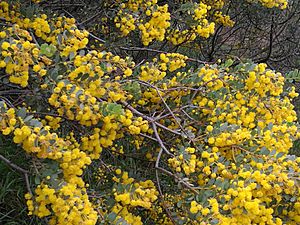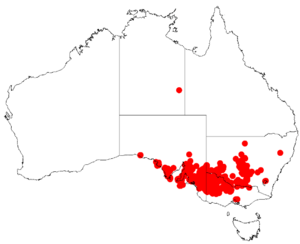Grey mulga facts for kids
Quick facts for kids Grey mulga |
|
|---|---|
 |
|
| Scientific classification | |
| Genus: |
Acacia
|
| Species: |
brachybotrya
|
 |
|
| Occurrence data from AVH | |
Acacia brachybotrya, also known as grey mulga or grey wattle, is a type of shrub that grows only in Australia. It belongs to a large group of plants called Acacia.
What Does Grey Mulga Look Like?
This plant is a bushy, spreading shrub. It usually grows between 1 to 3 metres (3.3 to 9.8 ft) tall. It can often grow even wider than it is tall.
Its leaves are a grey-green color and are flat. These special leaves are called phyllodes. They are shaped like a narrow oval or a wider oval. Each phyllode is about 3.5 cm (1.4 in) long and 15 mm (0.59 in) wide.
The grey mulga blooms from July to November. It grows bright yellow, round flower-heads. These flower-heads appear in groups of two to five.
After the flowers, long, dark brown seed pods grow. They are mostly straight or slightly curved. These pods are about 7 cm (2.8 in) long and 6 mm (0.24 in) wide. Inside the pods are dark brown to black seeds. The seeds are somewhat flat and oval-shaped. They are around 7 mm (0.28 in) long and 4 mm (0.16 in) wide.
How Was Grey Mulga Named?
A botanist named George Bentham first officially described this plant in 1842. He wrote about it in a book called Notes on Mimoseae, with a synopsis of species. This book was part of William Jackson Hooker's work.
Later, in 2003, another botanist, Leslie Pedley, changed its name to Racosperma brachybotryum. But then, in 2006, it was moved back to the Acacia group.
The second part of its scientific name, brachybotrya, comes from Greek words. Brachys means "short" and botrys means "spike." This name describes its flowers, which grow on short stems.
Where Does Grey Mulga Grow?
The grey mulga grows in many places across southeastern Australia. It is found in areas that are quite dry, known as semi-arid regions. You can find it from Yalata in South Australia all the way to Bendigo in Victoria. It also grows as far north as Nymagee in New South Wales.
This plant can grow in many different types of soil. It is often found in areas with "mallee" trees. Mallee is a type of Australian bushland where many eucalyptus trees grow with multiple stems from the ground.

